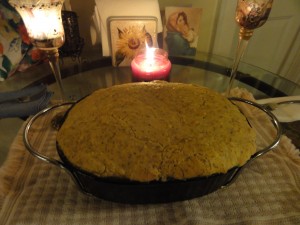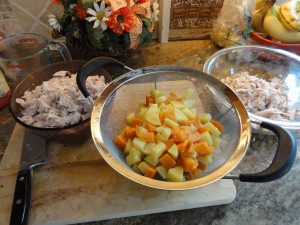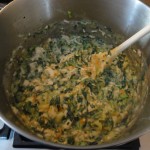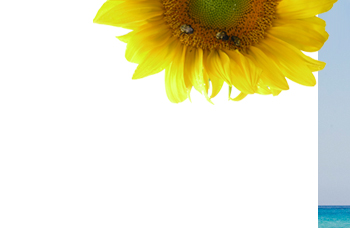Butter up your sour innards with this golden, feel-good dish

If I ever tell you that I just recovered from a bad stomach virus but that on the bright side I’d lost a few pounds, please throw me a dirty look. And if you ever tell me that you suffered with a bug and I say something cheerily like, “well, at least it’s a great way to lose weight!” feel free to kick me in the shins.
Happily, my shins are safe, because I promise not to say anything like that. There are few illness side effects more miserable, I think, than being unable to eat. Throwing up is painful, but not being able to appreciate the taste and texture of food is equally unhealthy. If you need to shed pounds for health reasons, I appreciate your plight; I need to lose weight, too. But let’s agree not to make it a big deal, nor punish ourselves for our enjoyment of food.
A few days after my recent illness, I celebrated my re-emerging desire for food with a rare turkey pot pie feast. The timing was ideal. I’d been yearning for a Sunday afternoon with little or no commitments (besides my late-morning Restorative yoga class), and as I was still tired and wobbly, I had no plans that weekend. My husband had done the grocery shopping the day before, and, hoping that I’d be up to pot pie come Sunday, I’d added the ingredients to our shopping list.
A downside to this dish is the time it requires to prepare. Nor is it politically nor calorically correct. It includes meat, dairy, butter (gobs of it), and if cooked as directed in the original recipe, will yield 850 calories per serving (not bad, actually; a store-bought cupcake can have 600 calories) with generous amounts of sodium, fat, and cholesterol (just to give you full disclosure) to boot.

I think the plusses (veggies, protein, fiber, for starters) outweigh the drawbacks, especially if you only make this recipe occasionally. You can easily reduce the salt and substitute for the butter. And while the steps are numerous, they are basic, requiring no culinary talent nor the use of complicated things like food processors. You can break up the recipe, too: cook the turkey breast one day, make the dish the next.
As you cook, the rewards will reach your nostrils well before the dish is done. Your kitchen (perhaps your whole house or apartment) will smell warm and wonderful. Your cats will be ever by your side in the kitchen as you work, for no other reason than to offer their unconditional love. The finished pot pie will last for many meals, and you’ll have bonus goodies if you use leftover broth, meat, and veggies for soup (I also freeze the broth to use as stock) and/or turkey salad. (The recipe calls for a 4 lb turkey breast, and since I can only seem to find smaller or much larger ones, I opt for the latter to get the extras.)
The post stomach bug pot pie feast felt so soothing that I vowed to make the dish again soon, and did so on New Year’s Eve. Calories be damned–I can’t think of a better dish to greet the new year with thoughts of healing and goodness.
Note: I clipped the recipe from First magazine years ago. My changes are noted for your consideration. If you don’t eat dairy or meat and substitute for these or any other preferences and needs, please let me know your ideas so I can share them here with other readers.
Turkey Pot Pie With Corn Bread Crust
1 carrot (or more, see below)
2 onions
1 turkey breast, 4 lbs
4 sprigs parsley
1 bay leaf
Salt and pepper (I skip these and use Adobo instead)
2 lbs yams or sweet potatoes (I use 1 large potato and 1 large yam, and sometimes add 1-2 carrots for more vitamins and pretty colors)
1 lb greens (ie, collards, kale, or spinach)
14 tbs butter (shhh, don’t tell the butter police!)
2 1/2 cups flour
3 cups milk
3/4 tsp dried rosemary
1 cup cornmeal
3 tbs flaxseed meal (optional, but adds an extra bit of crunch and fiber to the topping)
2 tsp baking powder
1 tbs sugar (I never use it; the crust tastes delicious without)
1 egg
Peel carrot and cut into chunks. Quarter 1 onion and put in soup pot with turkey breast, carrot, parsley, bay leaf, 1 tsp salt (if using), 1/4 tsp pepper, and water to cover. Bring to boil. Simmer until turkey is tender, about 2 hrs. Remove turkey. Strain broth and return to pot.
When turkey is cool, discard skin, pull meat from bones, and cut into bite-size pieces. Peel yams/potatoes and cut into cubes. Add to broth and boil until tender, about 15 min. Remove yams; save broth. Trim greens and cut into shreds. Chop remaining onion.
Melt 8 tbs butter in a saucepan over medium heat. (Note: I use the soup pot.) Add onion and cook until soft, about 2 min. Add 1/2 cup flour and stir until bubbly.  Gradually add 2 cups milk, 2 cups broth, rosemary, and seasoning to taste. Bring to boil, stirring; cook for 1 min.
Gradually add 2 cups milk, 2 cups broth, rosemary, and seasoning to taste. Bring to boil, stirring; cook for 1 min.
Stir in greens and cook until wilted. Add turkey and yams (and/or other veggies of your choice) and pour into 3-quart baking dish. Heat oven to 400 degrees.
Melt remaining 6 tbs butter. Combine 2 cups flour, cornmeal, flaxseed meal, and baking powder, as well as sugar and salt if using. Beat egg with 1 cup milk and pour into flour mixture with the butter. (I usually add some broth as well, adding more flavor and reducing the milk a bit.) Stir until well moistened. Spread batter over turkey mixture and bake until golden, about 20 minutes.
Enjoy!




